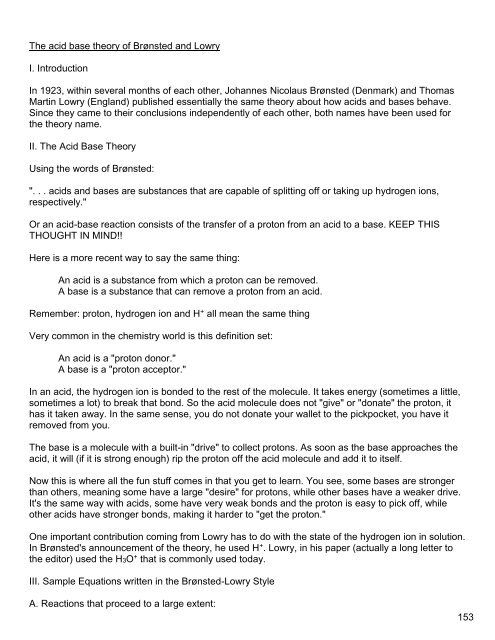You also want an ePaper? Increase the reach of your titles
YUMPU automatically turns print PDFs into web optimized ePapers that Google loves.
The acid base theory of Brønsted and Lowry<br />
I. Introduction<br />
In 1923, within several months of each other, Johannes Nicolaus Brønsted (Denmark) and Thomas<br />
Martin Lowry (England) published essentially the same theory about how acids and bases behave.<br />
Since they came to their conclusions independently of each other, both names have been used for<br />
the theory name.<br />
II. The Acid Base Theory<br />
Using the words of Brønsted:<br />
". . . acids and bases are substances that are capable of splitting off or taking up hydrogen ions,<br />
respectively."<br />
Or an acid-base reaction consists of the transfer of a proton from an acid to a base. KEEP THIS<br />
THOUGHT IN MIND!!<br />
Here is a more recent way to say the same thing:<br />
An acid is a substance from which a proton can be removed.<br />
A base is a substance that can remove a proton from an acid.<br />
Remember: proton, hydrogen ion and H + all mean the same thing<br />
Very common in the chemistry world is this definition set:<br />
An acid is a "proton donor."<br />
A base is a "proton acceptor."<br />
In an acid, the hydrogen ion is bonded to the rest of the molecule. It takes energy (sometimes a little,<br />
sometimes a lot) to break that bond. So the acid molecule does not "give" or "donate" the proton, it<br />
has it taken away. In the same sense, you do not donate your wallet to the pickpocket, you have it<br />
removed from you.<br />
The base is a molecule with a built-in "drive" to collect protons. As soon as the base approaches the<br />
acid, it will (if it is strong enough) rip the proton off the acid molecule and add it to itself.<br />
Now this is where all the fun stuff comes in that you get to learn. You see, some bases are stronger<br />
than others, meaning some have a large "desire" for protons, while other bases have a weaker drive.<br />
It's the same way with acids, some have very weak bonds and the proton is easy to pick off, while<br />
other acids have stronger bonds, making it harder to "get the proton."<br />
One important contribution coming from Lowry has to do with the state of the hydrogen ion in solution.<br />
In Brønsted's announcement of the theory, he used H + . Lowry, in his paper (actually a long letter to<br />
the editor) used the H3O + that is commonly used today.<br />
III. Sample Equations written in the Brønsted-Lowry Style<br />
A. Reactions that proceed to a large extent:<br />
153



